With food insecurity as their entrée, students learn the business of serving a cause
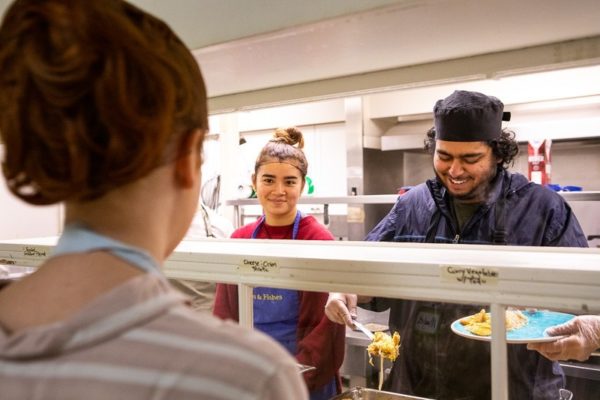
An SHA student volunteers at Ithaca's Loaves and Fishes as part of the course Hunger, Health, and Nonprofit Social Enterprise
Samay Bansal ’21 stood behind the counter in the cramped church kitchen, dishing out servings of cheese and onion strata. The free meal at Loaves & Fishes on this brisk November night also featured crusted tilapia, curried vegetables with tofu, and roasted cauliflower.
The long line of diners snaked into the parish hall of St. John’s Episcopal Church in downtown Ithaca, where families, singles, and the elderly were already enjoying the meal at long tables. “I like the fact that everyone is welcome here,” Bansal said during a break in his shift. “If you want a meal, you have a place here.”
While Bansal was at the community kitchen to volunteer for a three-hour shift, he was also fulfilling a course assignment for Hunger, Health, and Nonprofit Social Enterprise. Requiring ten hours of volunteer work is just one way HA 4315 teaches students what it’s like to struggle for food.
While most SHA courses focus on the for-profit side of hospitality, students in Hunger, Health, and Nonprofit Social Enterprise learn how food banks, soup kitchens, and food pantries serve people who don’t have access to a daily meal. They discover that in Tompkins County, 14,000 people, representing 13.5 percent of the population, are food-insecure—the third-highest rate of any county in the state.
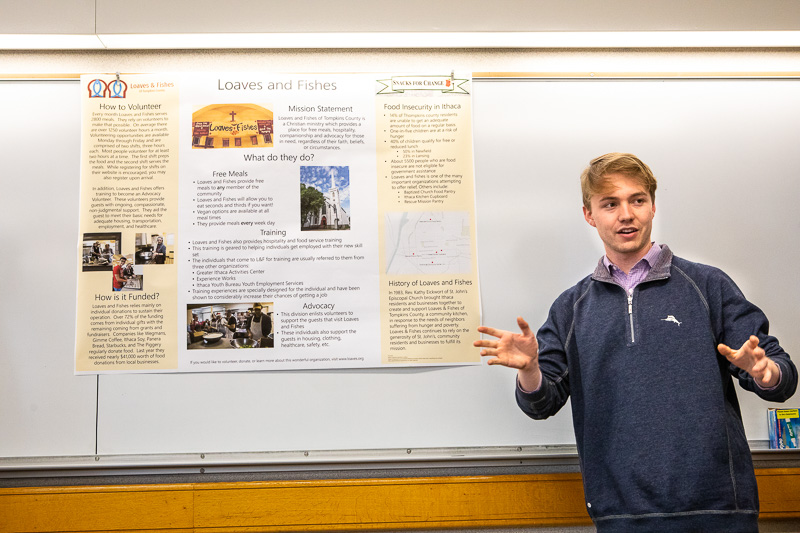
“Most people don’t understand how severe a problem it is in the United States as well as worldwide,” said Tasha Lam ’19, who took the class last fall. “I was personally very surprised to learn how food insecurity impacts Tompkins County in particular.”
Food insecurity exists not only in Tompkins County more broadly, but also on campus. Vincent Forand ’20 did part of his volunteer work for the course at Anabel’s Grocery, a store in Anabel Taylor Hall that provides low-cost produce to Cornell students. “You do have to fill out a survey and qualify,” he said. “It’s similar to food stamps.”
The volunteer requirement is one component of what makes Hunger, Health, and Nonprofit Social Enterprise a service-learning course, in which students apply their classroom learning to service projects that create positive change in the community. After completing their volunteer work, they are required to reflect on their experiences.
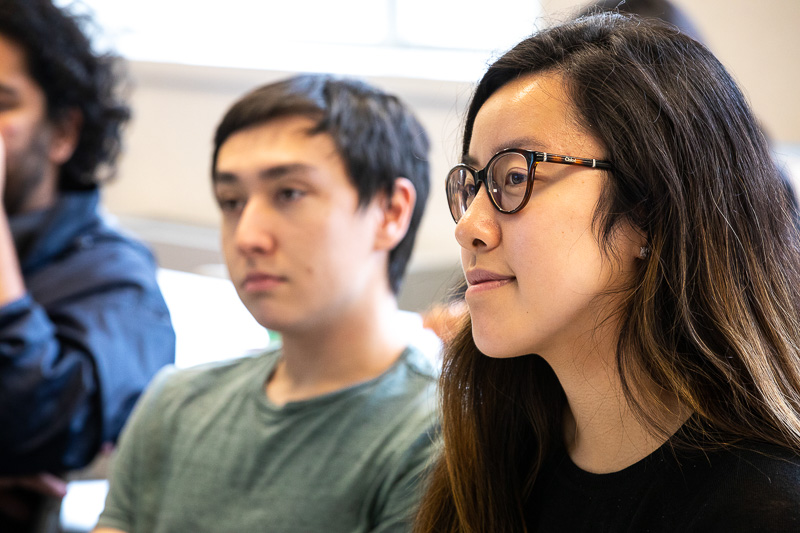
“It’s not just ‘Hey, I just volunteered at the food bank,’” said Heather Kolakowski ’00, lecturer in food and beverage management, who has taught the course since 2015. “It’s ‘This is what I did, this is the impact, and this is what it means for the future’—either your future or the social problem’s future.”
To prepare for the volunteer work, the students take a workshop offered by the Cornell Intergroup Dialogue Project, an academic initiative that teaches communication skills for students interacting with diverse groups of people. The workshop, presented at the beginning of the semester, addresses issues of identity, bias, and active listening.
The students also participate in a simulation activity called Hunger 101, in which they are given a profile of a Tompkins County resident who is struggling to access food. During the exercise, taught by a representative of the Food Bank of the Southern Tier, the students have to determine how much money they have to buy food, how to apply for food assistance, and where they can access a food pantry.
“I asked them to talk about how they felt during the simulation, and many of them said, ‘I just felt anxiety,’” Kolakowski said. “Some of the people who are profiled don’t have cars, so they were making the choice of ‘Do I pay for my medical bills or do I buy food?’”
In the middle of the semester, Kolakowski rents a van and drives the entire class to visit Foodlink, a large food bank in Rochester that not only supplies rations to food cupboards but also produces and sells sliced apples to local schools. The apple operation is an example of what students learn is a nonprofit social enterprise—a business model focused on addressing a social cause.
“Visiting the food bank was probably my favorite part of the class,” said Lam. “I had never been to any kind of food pantry program, and to actually be on the property and see how everything operates was really helpful.”

Another highlight of the course is planning and managing a fundraiser for the Fresh Snack Program, a program of the Youth Farm Project that provides free fruits and vegetables to nearly 1,600 elementary-school students in the Ithaca City School District. In this semester-long service assignment, the students learn how to market the event on campus and on Facebook, plan a silent auction, and solicit donations from local businesses.
Last fall, the fundraiser netted $3,700—more than twice the amount raised at the same event in 2017—and drew 105 people to Statler Hall on a Saturday afternoon to nibble on hors d’oeuvres and bid on gifts in the auction.
What made the event more successful this year, Kolakowski said, was a partnership with the course Catering and Special Events Management. While the catering students planned and prepared the food—a smorgasbord of onion and mushroom tarts, fried risotto balls, and mini pumpkin-apple pies—students in Kolakowski’s class were able to focus on marketing the event and collecting donations.
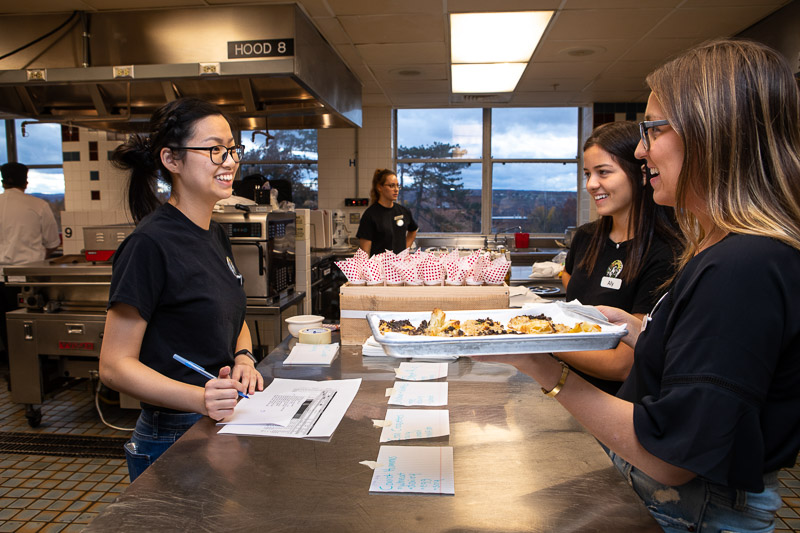
Lam served on two teams for the fundraiser, because she was enrolled in both courses. “I was able to plan this from the experience of two radically different classes,” she said. “I really liked how hands-on I was able to be with the project.”
The event not only helps the students gain fundraising skills, but it is also a critical revenue source for the Fresh Snack Program. “The students did the entire thing,” said Audrey Baker, co-chairwoman of the Youth Farm Project’s board and the former director of the Fresh Snack Program. “It’s not easy for our staff to spend lots of time fundraising and event planning when we’re trying to do programming, so it’s very helpful to have students bite into this as an annual project.”
Beyond finances, the course explores several other aspects of nonprofit foodservice management, including measuring impact, utilizing volunteers, and board governance. Two students in the class who had launched their own nonprofits before arriving at Cornell said the discussion of best practices for managing charitable organizations was invaluable.

“The reason why I wanted to take the course is I never had any instruction on operating a nonprofit,” said Forand, who cofounded Period, Inc., which supplies feminine hygiene products to homeless shelters and food pantries across the country. When he started the organization with a high-school friend in Portland, Oregon, Forand said, “we were kind of learning about nonprofits off the internet.”
Even though the nonprofit is well established, with more than 250 chapters in communities, high schools, and universities (including Cornell) and a budget of $484,000 last year, Forand found the course useful. “Some of the things that I learned come down to the nitty gritty—IRS filings, how to understand whether nonprofits are efficient, and how to manage volunteers,” he said.
Bansal also founded a nonprofit, the Million Meals Mission, to provide free food to the needy in his hometown of Ludhiana, India. Since its launch in 2016, the project has distributed nearly 90,000 meals and has raised more than $5,000.
Bansal has gained a better understanding of the technical aspects of running a nonprofit, such as managing staff and securing grants, since taking the course, he said. “I think the class was very practical, because you actually learn how organizations work.”

Although the volunteer work was required for the course, several students said they had been inspired to continue working with nonprofits on and off campus. ILR student Natasha Santos ’19 said she will keep working with the Cornell Food Recovery Network, which collects leftover food from two of the dining halls on campus and donates it to local food pantries.
“This wasn’t the typical soup kitchen experience where you get to deal directly with people,” she said. “It was more operational in a sense, and I really enjoyed that.”
Alumni who were students between 1988 and 2008 may remember Housing and Feeding the Homeless (or Exploring Social Responsibility: Hunger and Homelessness, the name it took on in 2005). The course was created by SHA faculty members James Eyster ’69, PhD ’77 and Ann Hales and taught in its later years by Therese O’Connor. While Housing and Feeding the Homeless explored public- and private-sector approaches to addressing hunger, poverty, and homelessness, Hunger, Health, and Nonprofit Social Enterprise uses the problem of food insecurity as a context for teaching about nonprofit social enterprise more generally. “It’s something that the Hotel School has been highlighting, which is hospitality through service and how a hospitality degree can impact lots of different industries,” Kolakowski said.
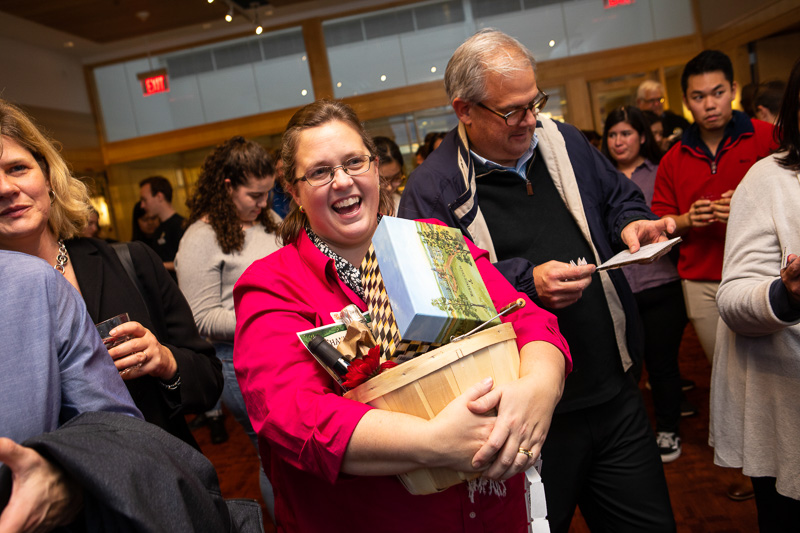
Kolakowski, who has an associate’s degree from the Culinary Institute of America and an MBA from Empire State College in addition to her Cornell degree, hopes the course will grow and draw students from across campus who want to work with organizations that are combating hunger and food insecurity in Tompkins County.
“This course addresses the idea of engaging with your community and thinking beyond just the academics of our classes,” she said. “My hope is that after the class, when the students go out into the industry, they remember some of the facts and experiences from the course, and that it will help them be better leaders and better individuals within their communities.”
Photos by Jon Reis.
